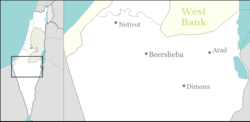Anim Synagogue
| Anim Synagogue | |
|---|---|
 The ancient former synagogue, in 2010 | |
| Religion | |
| Affiliation | Judaism (former) |
| Ecclesiastical or organisational status | |
| Status | Ruins |
| Location | |
| Location | near Arad, Yatir Forest, Southern District |
| Country | Israel |
Location of the ancient former synagogue of the northern boundary of the Negev desert | |
| Geographic coordinates | 31°20′33″N 35°03′42″E / 31.3425°N 35.061667°E |
| Architecture | |
| Style | |
| Date established | c. 4th century CE |
| Specifications | |
| Length | 14.5 m (48 ft) |
| Width | 8.5 m (28 ft) |
| Materials | Hewn stone |
| Anim Synagogue | |
 Synagogue interior | |
| History | |
| Abandoned | 8th century CE |
| Periods | Roman-Byzantine |
| Site notes | |
| Excavation dates | 1988–89 |
| Archaeologists | Z. Ilan & Dan Urman |
| Public access | Yes |
The Anim Synagogue is an ancient former Jewish synagogue, located approximately 25 km (16 mi) drive northwest of Arad, in the Yatir Forest, immediately south of the Green Line, in the Southern District of Israel. The ancient synagogue was in use during the 4th–7th centuries CE. The site is recognized as a National Heritage Site of Israel.
History: the two Anim villages
[edit]The synagogue is located at an ancient site identified with the Anim mentioned in the Bible (Joshua 15:50). It is also believed to be the site of the large Jewish village of Anaya (Άναιά) during the Roman-Byzantine period.[1] Eusebius mentions the same village in his Onomasticon as being one of two villages in his day, located south of Hebron, and bearing the same name.[2] One of the two villages, he writes, had a settlement of Jews, while the other, of Christians.[2][3]
Rabbi Shimon ben Yehudah, mentioned in Pesikta Rabbati, came from the village of Anim.[4]
The building functioned as a synagogue until the seventh or eighth century when it was turned into a mosque.[5]
The site of the ancient Jewish village is now known as Lower Horvat Anim (Arabic Khirbet Ghuwein et-Taḥta, lit. 'Ruins of Lower Ghuwein'; grid position 156/084 PAL), with a neighbouring contemporary Christian village at Upper Horvat Anim (Arabic Khirbet Ghuwein al-Fauqa, lit. 'Ruins of Upper Ghuwein') just 2 km northeast from it.[6][7][8] Ben-Yosef places the site of the Upper Horvat Anim at a distance of 5 km northeast of the lower site (grid position 1583/0855 PAL).[2] Excavations at Upper Horvat Anim have uncovered the remains of a larger regional Byzantine church outside the village,[2] overlooking it from the hill to the east and joined to it by a pathway—a configuration repeatedly met in the Southern Hebron Hills.[7]
Description
[edit]The synagogue was discovered during an excavation conducted in 1987. It consists of a rectangular prayer hall orientated towards Jerusalem measuring 14.5 by 8.5 metres (48 ft × 28 ft), an entrance portico and a courtyard with rooms on both sides.[1] Hewn stone walls still stand to a height of 3.5 m (11 ft) and two entrances on the east side survive with their lintels intact. Evidence of a mosaic floor was found beneath the current stone slab flooring[1] and fragments of an inscription remain.[5]
See also
[edit]- Ancient synagogues in the Palestine region - refers to the entire Palestine region/Land of Israel
- Ancient synagogues in Israel - refers to the modern State of Israel
- Archaeology of Israel
- History of the Jews in Israel
- List of synagogues in Israel
- Oldest synagogues in the world
References
[edit]- ^ a b c Urman, Dan; Flesher, Paul Virgil McCracken (1998). Ancient Synagogues: Historical Analysis and Archaeological Discovery. BRILL. pp. 135–136. ISBN 978-90-04-11254-4. Retrieved October 2, 2010.
- ^ a b c d Ben-Yosef, Sefi [in Hebrew], ed. (n.d.). Israel Guide - Judaea (A useful encyclopedia for the knowledge of the country) (in Hebrew). Vol. 9. Jerusalem: Keter Publishing House, in affiliation with the Israel Ministry of Defence. p. 220. OCLC 745203905.
{{cite book}}: CS1 maint: year (link), s.v. חורבות ענים - ^ Chapmann III, R.L.; Taylor, J.E., eds. (2003). Palestine in the Fourth Century A.D.: The Onomasticon by Eusebius of Caesarea. Translated by G.S.P. Freeman-Grenville. Jerusalem: Carta. pp. 23, 110. ISBN 965-220-500-1. OCLC 937002750.
Tribe of Judah. There is another Anaia near the first, which now happens to be completely Christian, lying east of the first.
, s.v. Anaia I - ^ Pesikta Rabbati (n.d.). Meir Ish Shalom of Vienna (ed.). Midrash Pesikta Rabbati (in Hebrew). Israel: not identified. p. 118a (Ten commandments - Third section). OCLC 249274973. (reprinted from 1880 edition)
- ^ a b Stemberger, Günter (2000). Jews and Christians in the Holy Land: Palestine in the Fourth Century. Continuum International Publishing Group. pp. 150–151. ISBN 978-0-567-08699-0. Retrieved October 2, 2010.
- ^ Tsafrir, Y.; Leah Di Segni; Judith Green (1994). (TIR): Tabula Imperii Romani. Iudaea, Palestina: Eretz Israel in the Hellenistic , Roman and Byzantine Periods; Maps and Gazetteer. Jerusalem: Israel Academy of Sciences and Humanities. p. 62. ISBN 965-208-107-8.
- ^ a b Bar, Doron. 'The Christianisation of Rural Palestine during_Late Antiquity', Journal of Ecclesiastical History, Vol. 54, No. 3, July 2003, pp.401–421; p.413.
- ^ Horvat 'Anim at BibleWalks.com, accessed 16 July 2019
External links
[edit] Media related to Anim synagogue at Wikimedia Commons
Media related to Anim synagogue at Wikimedia Commons- Chen, D.; Milson, D. "The Design of the Ancient synagogues in Judea: Horvat Ma'on and Horvat 'Anim" (PDF). christusrex.org. Archived from the original (PDF) on October 4, 2012.


